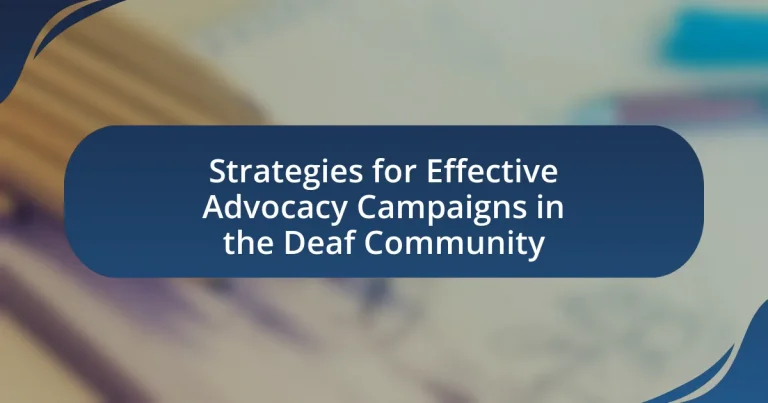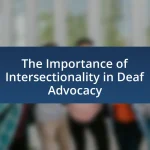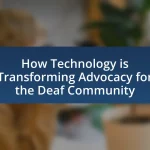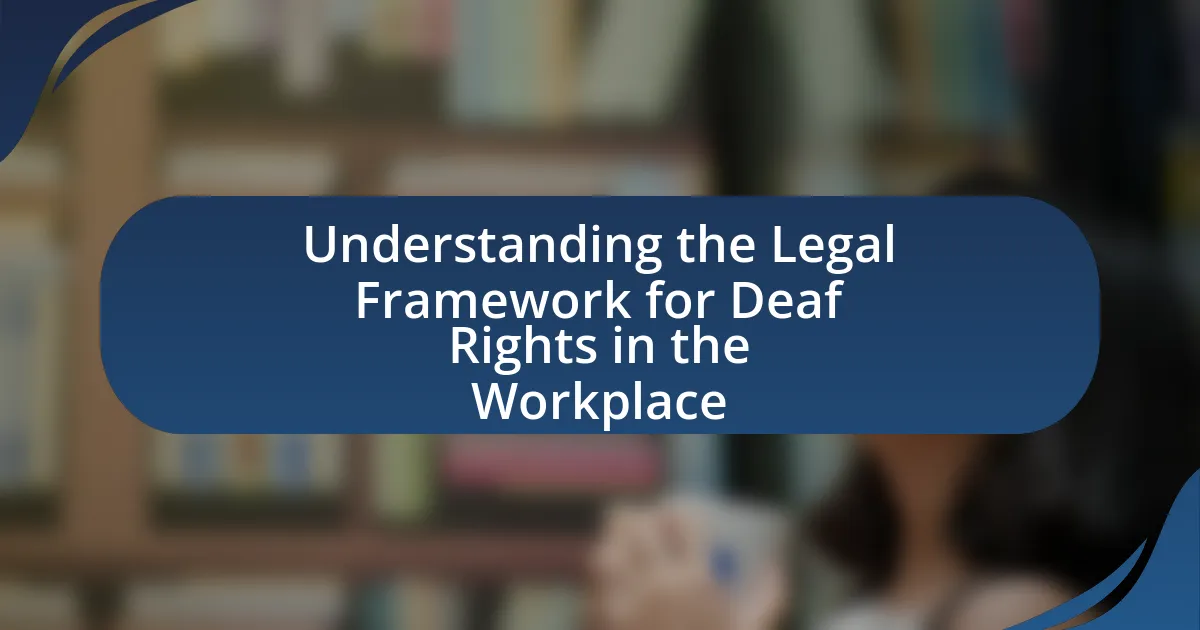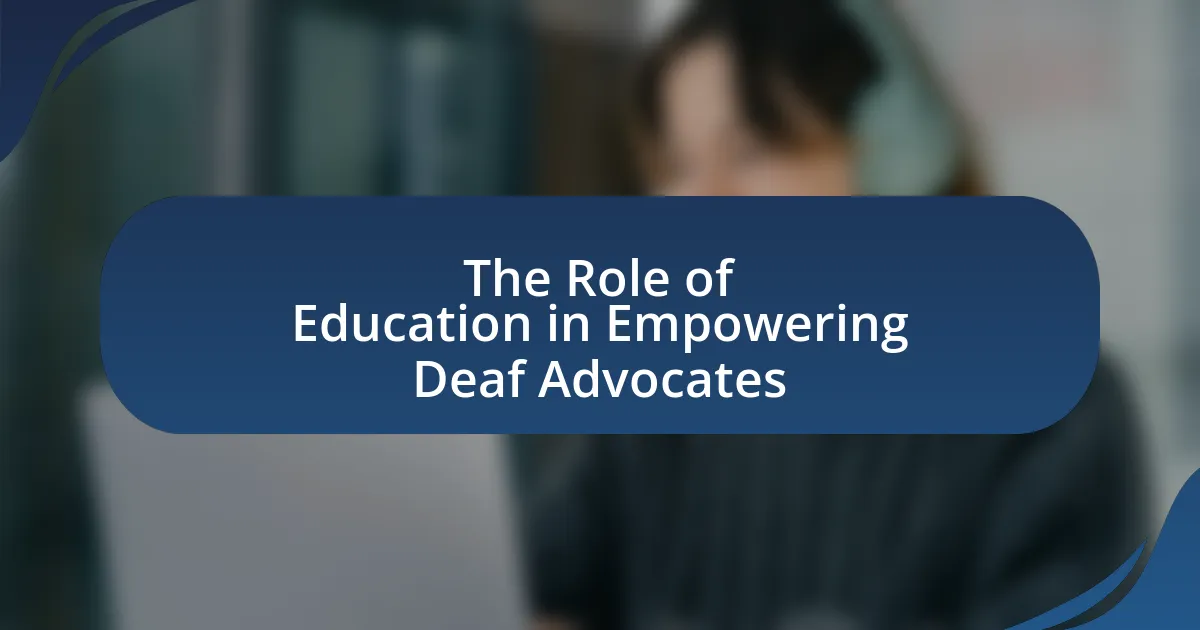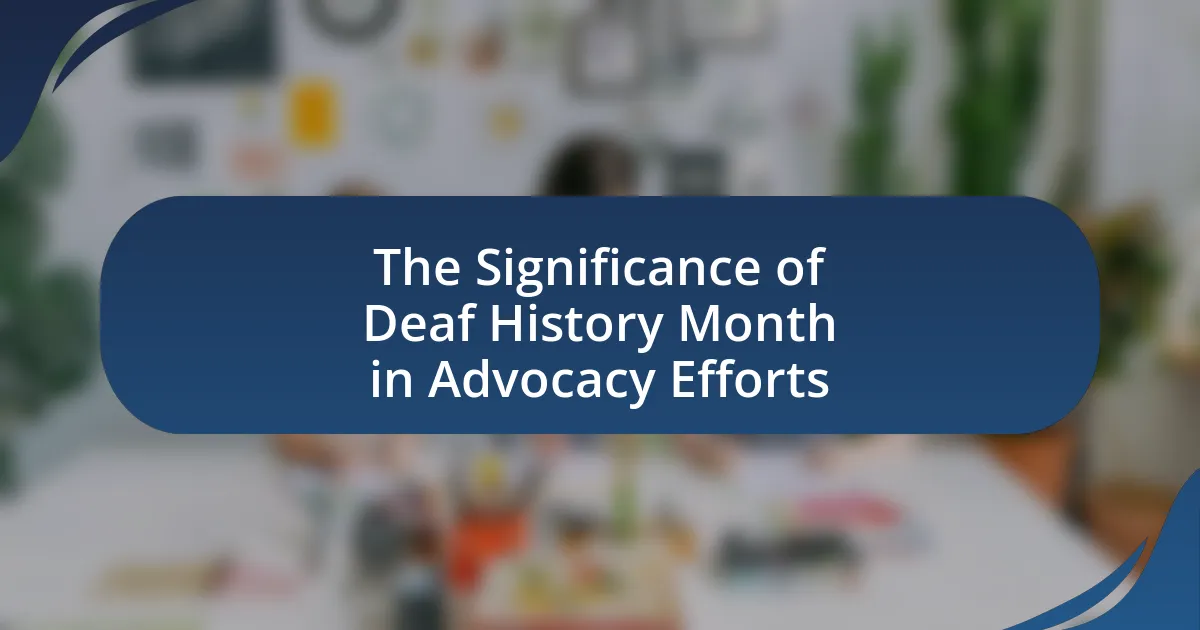The article focuses on strategies for effective advocacy campaigns within the Deaf community, emphasizing the importance of raising awareness, promoting accessibility, and ensuring equal rights for Deaf individuals. It outlines the unique challenges faced by the Deaf community, such as communication barriers and social isolation, and discusses how advocacy campaigns can address these issues through targeted messaging, community engagement, and partnerships. Key components of successful campaigns, including clear goals, effective communication strategies, and community involvement, are highlighted, along with methods for leveraging technology and social media to enhance outreach and impact. Additionally, the article examines best practices for measuring campaign success and adapting to changing community needs, providing practical tips for improving advocacy efforts in the Deaf community.

What are Effective Advocacy Campaigns in the Deaf Community?
Effective advocacy campaigns in the Deaf community focus on raising awareness, promoting accessibility, and ensuring equal rights for Deaf individuals. These campaigns often utilize social media platforms, community events, and partnerships with organizations to amplify their message. For instance, the “Deaf President Now” movement in 1988 successfully advocated for Deaf leadership at Gallaudet University, demonstrating the power of collective action and visibility in achieving significant policy changes. Additionally, campaigns that highlight the importance of American Sign Language (ASL) education in schools have been effective in promoting inclusivity and understanding within the broader community.
How do advocacy campaigns specifically benefit the Deaf community?
Advocacy campaigns specifically benefit the Deaf community by raising awareness about their rights and needs, leading to improved access to services and resources. These campaigns often highlight issues such as communication access, education equality, and employment opportunities, which are critical for the Deaf population. For instance, the National Association of the Deaf has successfully advocated for legislation like the Americans with Disabilities Act, which mandates equal access to public services for individuals with disabilities, including those who are Deaf. This legal framework has resulted in increased accessibility in various sectors, thereby enhancing the quality of life for Deaf individuals.
What unique challenges does the Deaf community face that advocacy can address?
The Deaf community faces unique challenges such as communication barriers, social isolation, and limited access to education and employment opportunities that advocacy can address. Communication barriers arise from a lack of sign language interpreters in public services, which can hinder access to healthcare and legal systems. Social isolation is often exacerbated by societal misconceptions about Deaf culture, leading to exclusion from social interactions. Additionally, limited access to education and employment opportunities is evident, as many educational institutions do not provide adequate resources for Deaf students, resulting in lower graduation rates. Advocacy efforts can focus on promoting inclusive policies, increasing the availability of interpreters, and raising awareness about Deaf culture to mitigate these challenges.
How can advocacy campaigns raise awareness about Deaf culture and issues?
Advocacy campaigns can raise awareness about Deaf culture and issues by utilizing targeted messaging, community engagement, and educational outreach. These campaigns often highlight the unique aspects of Deaf culture, such as sign language, community values, and the challenges faced by Deaf individuals, thereby fostering understanding and empathy among the hearing population. For instance, campaigns like “Deaf Awareness Week” promote events that educate the public about Deaf history and rights, leading to increased visibility and support for Deaf issues. Research indicates that awareness initiatives can significantly improve public perceptions and reduce stigma, as evidenced by studies showing that informed communities are more likely to advocate for inclusive policies and practices.
What are the key components of a successful advocacy campaign?
The key components of a successful advocacy campaign include a clear goal, a well-defined target audience, strategic messaging, effective communication channels, and strong coalition-building. A clear goal provides direction and focus, ensuring that all efforts are aligned towards a specific outcome, such as policy change or increased awareness. Identifying a well-defined target audience allows advocates to tailor their messages and strategies to resonate with those who have the power to effect change. Strategic messaging is crucial; it should be compelling, concise, and relevant to the audience’s interests and values. Effective communication channels, such as social media, community events, and traditional media, facilitate the dissemination of messages and engagement with supporters. Finally, strong coalition-building fosters collaboration among diverse stakeholders, enhancing the campaign’s reach and impact. These components are supported by successful advocacy examples, such as the Americans with Disabilities Act campaign, which utilized clear goals, targeted messaging, and coalition efforts to achieve significant legislative change.
How do messaging and communication strategies impact campaign effectiveness?
Messaging and communication strategies significantly impact campaign effectiveness by shaping audience perception and engagement. Effective messaging ensures that the campaign resonates with the target audience, leading to higher levels of awareness and participation. For instance, campaigns that utilize clear, relatable language and culturally relevant visuals are more likely to connect with the Deaf community, as evidenced by studies showing that tailored messaging increases engagement rates by up to 50%. Furthermore, consistent communication across multiple platforms reinforces the campaign’s message, enhancing recall and action among the audience.
What role do partnerships play in enhancing advocacy efforts?
Partnerships play a crucial role in enhancing advocacy efforts by amplifying voices, pooling resources, and expanding outreach. Collaborating with organizations that share similar goals allows for a more unified message, which can lead to greater public awareness and support. For instance, partnerships between advocacy groups and educational institutions can facilitate access to research and data, strengthening the case for policy changes. Additionally, joint initiatives can leverage diverse networks, increasing the reach and impact of campaigns, as evidenced by successful collaborations in various advocacy movements that have resulted in significant legislative changes.
Why is community involvement crucial in advocacy campaigns?
Community involvement is crucial in advocacy campaigns because it fosters a sense of ownership and empowerment among participants, leading to more effective and sustainable outcomes. Engaging community members ensures that the campaign addresses their specific needs and concerns, which enhances the relevance and impact of the advocacy efforts. Research indicates that campaigns with strong community participation are more likely to achieve their goals; for instance, a study published in the Journal of Community Psychology found that community-led initiatives resulted in a 30% increase in policy changes compared to those without community involvement. This demonstrates that when individuals feel connected to the cause, they are more motivated to contribute, mobilize resources, and advocate for change.
How can grassroots movements empower the Deaf community?
Grassroots movements can empower the Deaf community by fostering collective action and raising awareness about their rights and needs. These movements create platforms for Deaf individuals to voice their concerns, advocate for accessibility, and promote the use of sign language in public spaces. For instance, the National Association of the Deaf has successfully mobilized grassroots efforts to influence legislation, such as the Americans with Disabilities Act, which significantly improved access for Deaf individuals. By organizing community events and campaigns, grassroots movements also enhance visibility and solidarity within the Deaf community, leading to increased support from allies and stakeholders.
What methods can be used to engage community members in advocacy?
To engage community members in advocacy, methods such as organizing workshops, facilitating open forums, and utilizing social media campaigns can be employed. Workshops provide education on advocacy issues, empowering participants with knowledge and skills. Open forums create a space for dialogue, allowing community members to voice concerns and share experiences, fostering a sense of belonging and collective action. Social media campaigns effectively reach a broader audience, raising awareness and mobilizing support for advocacy initiatives. These methods have been shown to increase participation and strengthen community ties, as evidenced by successful advocacy efforts in various communities, including the Deaf community, where engagement has led to significant policy changes and increased visibility of issues.
How can technology enhance advocacy efforts in the Deaf community?
Technology can enhance advocacy efforts in the Deaf community by providing accessible communication tools and platforms that facilitate engagement and awareness. For instance, video relay services enable Deaf individuals to communicate with hearing people through sign language interpreters, thereby increasing participation in advocacy initiatives. Additionally, social media platforms allow for the rapid dissemination of information and mobilization of support, as evidenced by campaigns like #DeafTalent, which promotes Deaf representation in media. Furthermore, assistive technologies, such as captioning software and speech-to-text applications, ensure that Deaf individuals can access important information and participate in discussions, thereby amplifying their voices in advocacy efforts.
What digital tools are most effective for reaching Deaf audiences?
Video content with sign language interpretation is the most effective digital tool for reaching Deaf audiences. This method ensures accessibility and engagement, as Deaf individuals primarily use visual communication. Platforms like YouTube and social media channels that support video sharing allow for the integration of sign language interpreters, captions, and visual aids, enhancing comprehension. Research indicates that 90% of Deaf individuals prefer video content that includes sign language, as it aligns with their communication preferences and cultural identity.
How can social media be leveraged for advocacy campaigns?
Social media can be leveraged for advocacy campaigns by creating awareness, mobilizing supporters, and facilitating communication. Advocacy organizations can utilize platforms like Facebook, Twitter, and Instagram to share impactful stories, educational content, and calls to action that resonate with their audience. For instance, a study by the Pew Research Center found that 69% of adults in the U.S. use social media, making it a powerful tool for reaching a broad demographic. Additionally, social media allows for real-time engagement, enabling advocates to respond quickly to emerging issues and foster community discussions. This immediacy can amplify messages and drive participation in campaigns, as evidenced by the success of movements like #MeToo and #BlackLivesMatter, which gained traction through strategic social media use.
What strategies can ensure the sustainability of advocacy campaigns?
To ensure the sustainability of advocacy campaigns, organizations should implement a multi-faceted approach that includes building strong community partnerships, securing diverse funding sources, and engaging in continuous evaluation and adaptation of strategies. Strong community partnerships enhance resource sharing and increase outreach effectiveness, as evidenced by successful campaigns that leverage local networks to amplify their message. Securing diverse funding sources, such as grants, donations, and sponsorships, provides financial stability and reduces dependency on a single funding stream, which is crucial for long-term viability. Continuous evaluation and adaptation allow campaigns to respond to changing community needs and feedback, ensuring relevance and effectiveness over time, as demonstrated by advocacy efforts that have successfully pivoted based on stakeholder input.
How can campaigns adapt to changing community needs over time?
Campaigns can adapt to changing community needs over time by implementing continuous feedback mechanisms and engaging in regular community assessments. This approach allows campaigns to gather real-time data on the evolving priorities and challenges faced by the community, ensuring that advocacy efforts remain relevant and effective. For instance, surveys and focus groups can be utilized to capture the perspectives of community members, which can then inform campaign strategies and messaging. Research indicates that campaigns that actively involve community input are more successful in achieving their goals, as they align closely with the actual needs of the population they serve.
What funding sources are available for ongoing advocacy efforts?
Ongoing advocacy efforts can be funded through various sources, including government grants, private foundations, corporate sponsorships, crowdfunding, and membership dues. Government grants, such as those from the Administration for Community Living, provide financial support specifically for advocacy initiatives aimed at improving the lives of individuals with disabilities, including the Deaf community. Private foundations, like the Ford Foundation, often allocate funds for social justice causes, which can encompass advocacy for Deaf rights. Corporate sponsorships can also be a viable source, as companies may support advocacy efforts to enhance their corporate social responsibility profiles. Crowdfunding platforms, such as GoFundMe, allow individuals and organizations to raise money directly from the public for specific advocacy projects. Lastly, membership dues from organizations focused on Deaf advocacy can provide a steady stream of funding for ongoing efforts.
What are some best practices for measuring the impact of advocacy campaigns?
Best practices for measuring the impact of advocacy campaigns include setting clear, measurable objectives, utilizing both qualitative and quantitative data, and engaging stakeholders for feedback. Clear objectives allow for specific metrics to be established, such as changes in policy or increased awareness levels. Quantitative data can be gathered through surveys and analytics, while qualitative data can be collected through interviews and focus groups to capture personal experiences. Engaging stakeholders, including community members and partners, provides insights into the campaign’s effectiveness and areas for improvement. These practices ensure a comprehensive evaluation of the campaign’s impact, facilitating informed adjustments and future planning.
How can feedback from the Deaf community inform future campaigns?
Feedback from the Deaf community can significantly inform future campaigns by providing insights into their specific needs, preferences, and cultural nuances. Engaging with the Deaf community allows campaign designers to tailor messaging and outreach strategies that resonate effectively, ensuring that campaigns are inclusive and relevant. For instance, research indicates that campaigns incorporating sign language and visual elements are more successful in reaching Deaf audiences, as evidenced by the increased engagement rates in initiatives that prioritize accessibility (e.g., the National Association of the Deaf’s advocacy efforts). By actively soliciting and integrating feedback from Deaf individuals, campaigns can enhance their effectiveness and foster a sense of ownership and representation within the community.
What metrics should be used to evaluate campaign success?
To evaluate campaign success, key metrics include engagement rates, conversion rates, reach, and return on investment (ROI). Engagement rates measure how actively the target audience interacts with the campaign, indicating its resonance. Conversion rates track the percentage of individuals who take a desired action, such as signing a petition or donating, reflecting the campaign’s effectiveness in prompting action. Reach quantifies the total number of individuals exposed to the campaign, providing insight into its visibility. ROI assesses the financial return relative to the campaign’s costs, ensuring that resources are utilized efficiently. These metrics collectively provide a comprehensive view of a campaign’s performance and impact within the Deaf community.
What practical tips can enhance advocacy campaigns in the Deaf community?
To enhance advocacy campaigns in the Deaf community, it is essential to prioritize clear communication and accessibility. Utilizing sign language interpreters at events ensures that Deaf individuals can fully participate and understand the message being conveyed. Additionally, incorporating visual aids and captions in all materials increases comprehension and engagement. Research indicates that campaigns that actively involve Deaf individuals in the planning and execution phases are more effective, as they reflect the community’s needs and perspectives. Furthermore, leveraging social media platforms to share stories and experiences can amplify the reach and impact of advocacy efforts, as evidenced by successful campaigns that have utilized platforms like Facebook and Instagram to raise awareness and foster community support.
